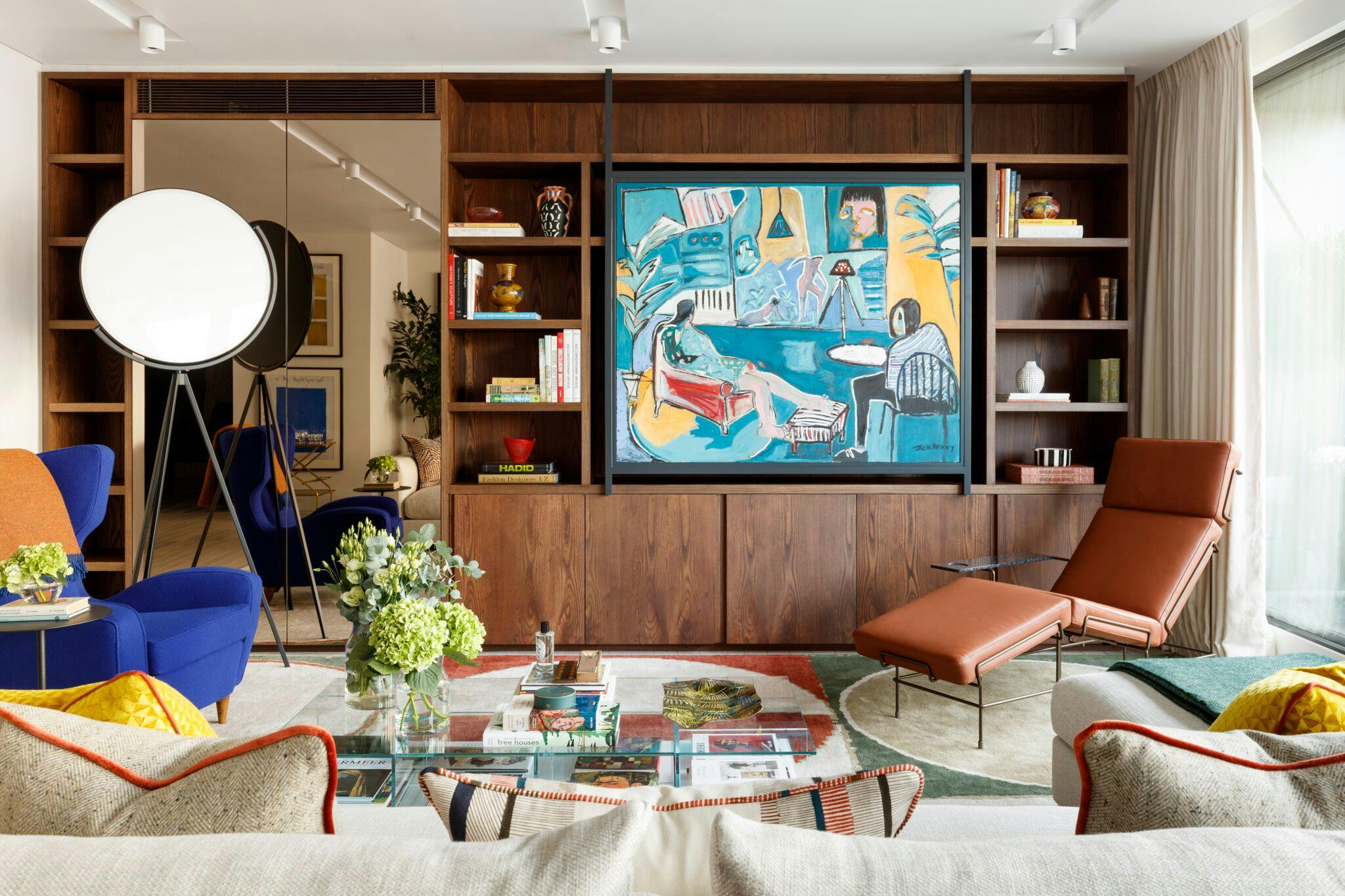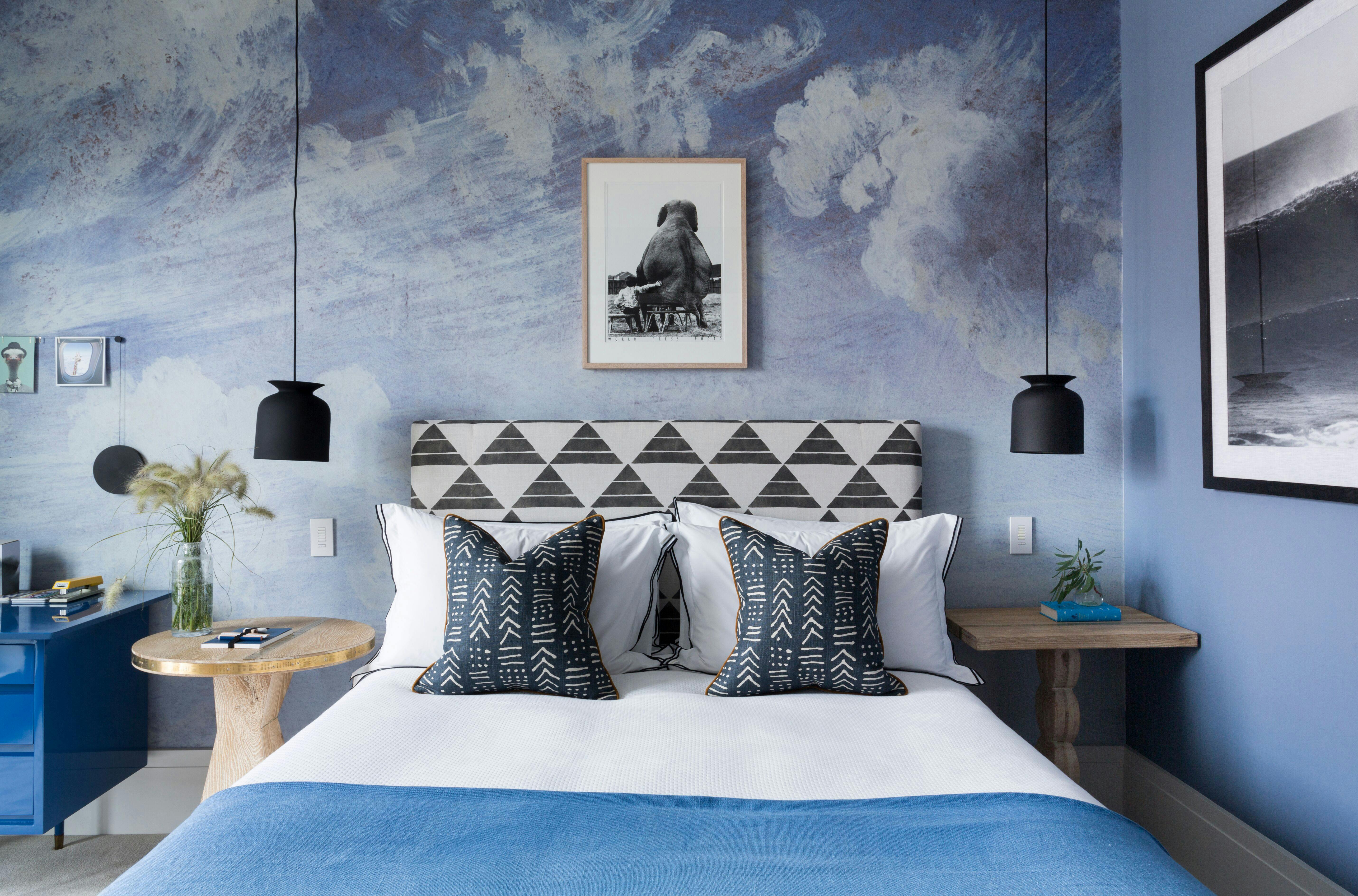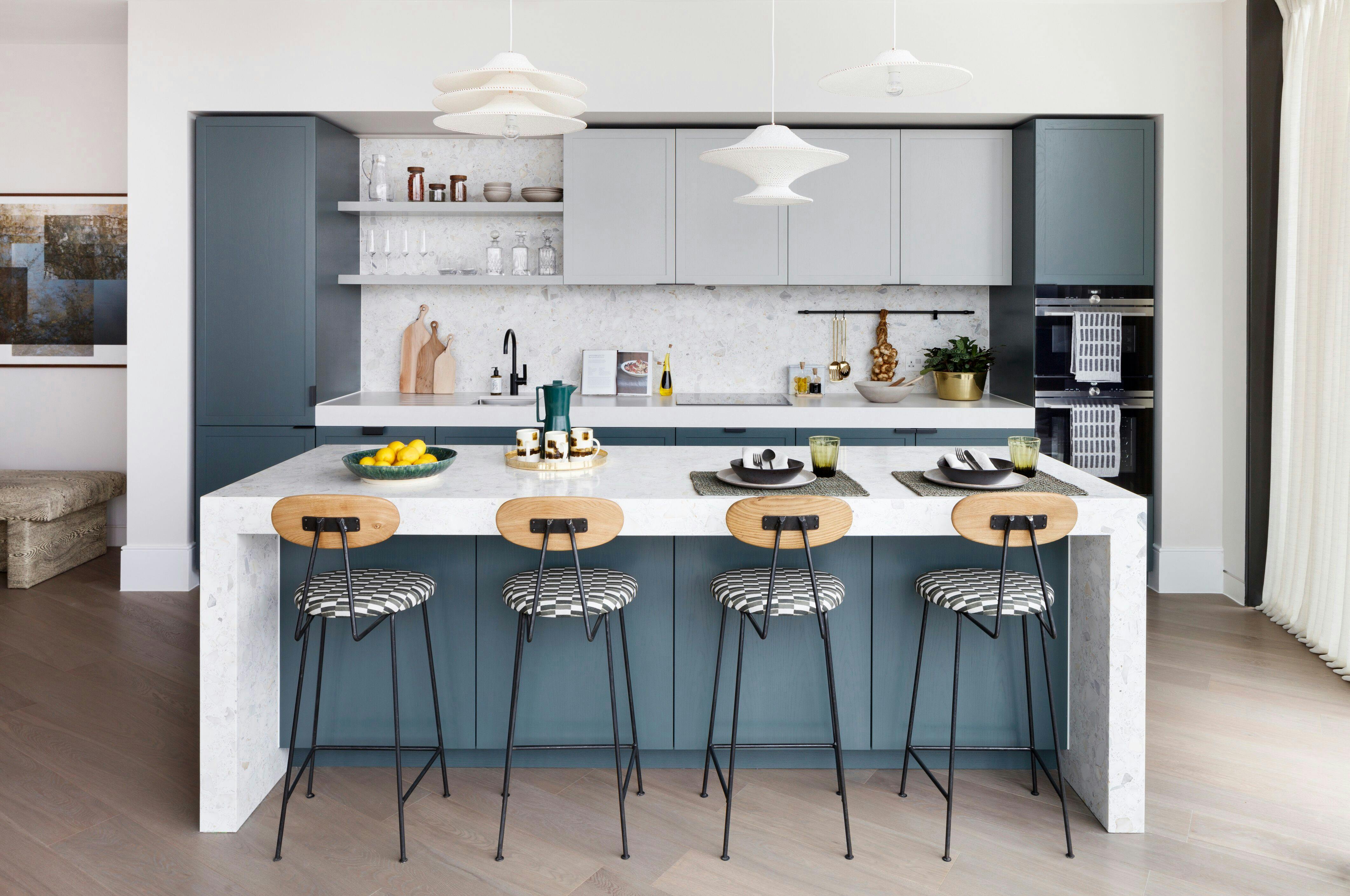Studio Ashby founder Sophie Ashby talks us through her rise to the top of London’s interior design scene – from her very first commission to delivering acclaimed projects at high-profile developments including Battersea Power Station, Holland Park Villas and Greenwich Peninsula – revealing her biggest sources of design inspiration, and the advantages of being the ‘wild card’ option…
You studied interior design at Parsons in New York; when did you first decide you wanted to be a designer – and why?

A theme that is quite common with interior designers applies to me also, which is that I moved a lot growing up.
With a South African mother and a British father, my childhood was spent living for stints in London, Stellenbosch (South Africa) and Devon and with fourteen or so moves, I got used to ‘doing up’ my bedroom. I’ve always been fascinated in the idea of home and how much it can mean to people, arranging my bedroom furniture, making my bed and putting my posters up as a kid, transformed a new unfamiliar space back into my sanctuary.
I love houses and am fascinated by how people live, what they surround themselves with and what makes a place a home. I decided I wanted to become an interior designer when I was a teenager as I had become very interested then in the importance of ‘home’ for a person and how life, for me anyway, feels much better when you have that connection to the place that you live and then venture out from into the world.

You went on to an apprenticeship with the renowned designer Victoria Fairfax; what did you learn from the experience?
I worked on some very special projects whilst with Victoria and I credit her with my understanding of colour and sense of proportion. She had a very impressive roster of clients and projects and I got to travel the world with her, working in Boston, Switzerland, Sussex and London. She taught me a lot about how to handle private clients; she was expert in treading that quite careful line between firmness and flexibility and made sure her studio provided the highest level of service.
Your next move was to the creative agency Spring & Mercer, where you headed up the interiors team, before setting up your own studio in 2014; who was your first client, and how did you win the commission?
I credit my time at Spring & Mercer as the period I started to really understand and discover my own interior style. I was still so young and inexperienced and my bosses at the time were very trusting and generous, allowing me to grow and develop through a lot of on-the-job learning.
The design fee was the same as my annual salary so I decided to take the leap
Whilst at Spring & Mercer we were approached by a London residential developer to dress a large townhouse just off Trafalgar Square; it wasn’t the sort of value and scale of project that suited Spring & Mercer so we declined, but the developer was keen for me to do it and offered me the job as my first commission if I were to leave and go out on my own. The design fee was the same as my annual salary so I decided to take the leap, knowing that I would be financially safe for a year. After three weeks on my own, I won another project and after five weeks another. It all sort of snowballed from there!
What was it like in the early days of the business, and what advice would you have for someone considering striking out on their own?
The early days were freeing; to be running my own business, calling all the shots, making my own mistakes and being solely responsible for the highs too was wonderfully satisfying. When I think back it was all pretty chaotic, I was living in a friend’s spare room as I’d just come out of a serious relationship, I was working from cafes on my laptop and persuaded my sister on her days off to set up trade accounts for me. I often think now that if I’d really understood what I was getting myself into, I would have waited a few more years to grow as a person and as a designer, but then I think my youthful ignorance and naivety have actually been quite useful too. I had no money to start the business with and have never needed any investment. I never had a business plan and certainly didn’t set out to create a company the size we are now.
My advice to anyone starting out would be to make sure you have a strong network of people around you who you’re not embarrassed to call up and ask a stupid question. A few really key people have really supported me, promoted me and endorsed me and it’s thanks to them that we are where we are now.

Your team is now twelve-strong, with a studio in Notting Hill; how many projects do you have on the go at any one time, and how involved are you personally on each one?
We tend to have between six and eight projects on at one time and I am involved personally in every single one. I want to keep it that way too as it’s easy, once you’re running a design business, to lose contact with the creative process but I love what I do and feel very strongly that I need to keep close to our projects. It’s my name above the door after all! I work with an incredible team of talented people who really care about what we do and nothing would happen without them. I have this sensation most days that I sort of just float around above everything, checking in at various stages and pushing the creative along whilst not actually doing anything particularly useful, the team actually develop, deliver and manage the process.
What do you enjoy most about your role now?
I like the variety of my day. No two days are the same and apart from Mondays, which are studio days, where I am chained to this little stool which I use to hop from designer to designer, checking in on projects. Each week is so varied. I wear many hats and really enjoy learning about the different aspects of running a business and pushing myself to be a stronger leader and more grown-up entrepreneur.
What is the main source of new business for the studio?
It’s all word of mouth. Quiet often, we are put forward by wider project teams like architects, project managers and contractors. Agents and developers also refer work our way on the residential development schemes. The studio has grown in the public eye over the years too as I’ve spent a lot of time working on our public image via social media and articles etc. so we actually now are starting to see some enquiries off the back of magazine coverage or Instagram which is exciting.
How important is Instagram and other social media to the business, and do you have any tips for making it work commercially?
Instagram is a great platform to build a brand profile and I do think that most people, myself included, now go to Instagram as a first port of call to check something out, before googling as it gives you such a quick, visual snapshot of what a company is all about. I have always tried to be very honest and real on the Studio Ashby Instagram account and I still run it myself, I am not ready to hand over the reins yet as it feels so personal. I like to think that the ‘realness’ of our posts, even down to how I write the captions is so important as anything that feel manufactured or fake is difficult to connect with.

Studio Ashby projects have ranged from super-prime heritage buildings to ultra-modern contemporary apartments; do the schemes share any particular qualities or characteristics, or is it important for each to remain completely unique?
Our mission is to create habitable spaces with identity. It doesn’t matter if that’s for a home, a restaurant or a commercial development, we apply the same creative approach that starts with envisioning the lives of the people who will inhabit it. We question what inspires them, what moves them and how we can fulfil their desires and support their needs with our design. Art plays a central role in our inspiration and process and I believe art has a vital place in every interior and no space feels complete without it. It’s through art that the spaces become highly personalised and unique.
Which developers, designers or architects have impressed you recently, and do you have a dream building (present or future) you would love to work on?
There are so many. I am very impressed by Clivedale and Lodha and the quality of stuff they’re building; I also think they clearly invest in design and to have a London, premium residential development designer by Patricia Urquiola (Lincoln Square) for example feels like an exciting new, more progressive chapter. We are working on a scheme with CAPCO in Covent Garden and I am really impressed with the way they work, they’re truly driven to be unique and create beautiful product. My dream is to design a boutique safari lodge but I don’t think there are any plans in London for one of those at the moment!
How much of an influence do current design trends have on your schemes (e.g. en vogue materials or colour palettes), and how do you ensure they will stand the test of time?
I think it’s foolish to weave trends into projects because they, by definition, are transient and temporary and become dull and passé so quickly, so we try to ignore them on the whole. I like to think we know what they are but we usually try and go the other direction. We prefer to reflect the personality of the client and the context of the project in our designs.
How much emphasis do today’s clients place on genuine craftsmanship (over, say, brand names or price), and has this changed in recent years?
Craft and the importance of quality craftsmanship in our projects can’t really be understated. The whole studio operates via the dialogue between designer and maker and the conversations we have around materiality, form, function and the value of the little details is the driving force behind our process. We design a lot of bespoke furniture and almost all of it is made in the UK by one- or two-man band workshops, who are specialists in their field. It’s a privilege to work with these makers and learn from them. We don’t really care for brand names, we’re much more interested in what it looks like, who made it and where it came from.

Are there any particularly unusual places you look for inspiration?
Travel is one of my biggest sources of design inspiration and visiting different places always clears my head and brings me fresh ideas. I’m always picking up objects and finding local suppliers everywhere I go for projects. I think a lot about the Bushveld and the Karoo; the greens, yellows, heathers, clays and burnt oranges, and after sunset how all the planting changes. The influences come through in many of my projects, for example I’ll use a basket weave design on the floor, which is very much an African style.
The hotel and resi sectors share a number of characteristics, but which is currently leading the way in terms of design? Are there any stand-out examples of design innovations that have caught your eye?
I have so many places but I’ll narrow them down! Ett Hem in Sweden is an intelligently designed hotel which is cosy and stylish, Ilse Crawford has made the place feel like a home away from home. With no “back of house” to speak of, the hotel flows as it would if you lived there.
The conversion of a former arts and crafts building, El Fenn in Marrakech is an impeccably styled boutique hotel in the heart of Marrakech with a rooftop pool and terrace which gives way to hypnotic views of the city. Each room is individual in its design with vibrant jewel-coloured walls, retro 1960s and 1970s furniture, Moroccan art, rugs and other beautiful bits and pieces. It’s a relaxing place to spend a few days with good food.
Having grown up in South Africa, studied in the US, and worked in the UK; have you picked up on any fundamental differences in either how the design sector works or in what HNW clients want between different continents?
I have found that ultimately everybody cares about the same things
I have found that ultimately everybody cares about the same things; from the comfort of a sofa (and a place to rest your head), to the practicality of a particular vanity top finish, a seamless flow of space, shower pressure, kid or dog proof fabric choices, the durability of a table top, the longevity of a design scheme, dimmer switches, fair value, quality craftsmanship, uniqueness, originality. There are small characteristics which define people from different cultures, which we really enjoy delving into and understanding, but most of the core principals of design are unifying and applicable to all projects and clients.
You are a Young Patron of the Royal Academy of Arts, a Decorex Ambassador and guest speaker at Central St Martins; how much support is there for emerging young designers in the UK, and what could the industry do to help the next generation of talent break out?
I actually think there is a lot of support for young designers in the UK; we have the BIID which is a very useful institution and one I really value being a part of.
More often than not, Studio Ashby is the ‘wild card’ option in the line-up of designers if we are pitching for work and this has often worked in our favour. I would encourage private clients and developers to invite at least one younger/newer/different design studio to pitch in your pile of three and see what they have to say. All you can ever ask for is a chance to be heard and so creating opportunities for emerging designers to pitch is a key part of this.

In the light of current events, how is your client base feeling about London as a place to live, work and invest?
I think they are very apprehensive and full of uncertainty, myself included. It’s impossible to predict what’s going to happen and so everyone is just sitting tight and waiting it out. I think London will always be a desirable place to live and an incredible city to work in so I am sure we will bounce back from whatever is coming our way.
Delivering top-end projects for demanding, discerning clients can be a stressful business; what do you do to relax?
I love spending time at home, with my husband Charlie, pottering, going for walks, having lunch together and visiting galleries. I try to do a bit of exercise and I make sure I get seven hours of sleep every night; I wish I was an early riser or someone who only needed five hours but alas, I love to sleep and does me the world of good.
Where would you like the studio to be in five years’ time?
I would like us to be in a beautiful office, with our own front door in an entirely ‘Studio Ashby’ styled environment, with a kitchen for making delicious lunches in for the team and our collaborators.
I would like to have a few key products for sale, maybe via a shop (I’ve always longed to be a shopkeeper).
What’s the most important piece of advice you’ve been given?
You go girl. Or various words of encouragement along those lines from my mother.



